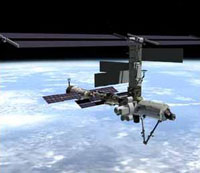- NASA Home
- | Centers
- | Marshall Home
- | Marshall News
- | Background
- | Facts
Search Marshall
|
Release date: 07/01
With the launch, the Station's third crew begins its four-month mission and continues through the landing of Space Shuttle Endeavour (STS-108) in early December. There are two Space Shuttle, two Soyuz and two Progress missions scheduled to fly to the International Space Station during Expedition Three. New science facilities and experiments will be added to lab equipment and continuing research projects launched aboard the two earlier science expeditions. Expedition Three will focus on the effects of space flight on bone and muscle mass during extended stays in space and how such phenomena may relate to similar conditions on Earth. Additional experiments during Expedition Three are intended to lead to new insights in the fields of human life sciences, biotechnology, education and video technology. Expedition Three crew members are Commander Frank L. Culbertson, an astronaut, Soyuz commander Vladimir Dezhurov and flight engineer Mikhail Turin, both cosmonauts. They will continue maintaining the station, adding to its capabilities and working with science teams on the ground to operate experiments and collect data. On Earth, a new cadre of controllers for Expedition Three will replace their Expedition Two colleagues in the International Space Station's Payload Operations Center at NASA's Marshall Space Flight Center in Huntsville, Ala. Controllers work in three shifts around the clock, seven days a week in the Payload Operations Center, the world's primary science command post for the Space Station. Its mission is to link Earth-bound researchers around the world with their experiments and astronauts aboard the Space Station.
During this expedition, research facilities to be launched to the Space Station include two EXPRESS (Expedite the Processing of Experiments to the Space Station) Racks and the Cellular Biotechnology Operations Support System (CBOSS). EXPRESS Racks are standardized payload racks that transport, store and support experiments on the station. Utilities provided to experiments by the racks include power, fluids, gasses, cooling, and data. EXPRESS Racks No. 4 and 5 will support a variety of experiments that could improve life on Earth and in space. CBOSS is designed to augment cell growth and research aboard the Space Station, providing preservation, temperature regulation and proper stowage of specimens during delivery, experimentation and return to Earth. The system is comprised of four elements: the Biotechnology Specimen Temperature Controller, the Biotechnology Refrigerator, the Gas Supply Module and the Biotechnology Cell Science Stowage-1 facility. EXPRESS Racks No. 1 and 2, as well as the Human Research Facility will continue to support existing and new experiments with power, cooling, fluids, data management and other utilities. One focus of Expedition Three science is the study of loss of bone mass and muscle atrophy that occurs during prolonged exposure to microgravity. This behavior resembles some forms of bone loss on Earth but is reversible. Treatment of bone and muscle mass loss in space may hold clues on how to treat similar conditions on Earth, while research on how to treat terrestrial bone and muscle conditions may aid NASA in its search for bone and muscle countermeasures for astronauts. Continuing from Expedition Two, the Sub-regional assessment of Bone Loss in the Axial Skeleton in Long-term Space Flight will measure bone loss and recovery experienced by crewmembers after flight. Other new experiments and payloads beginning with the Expedition Three crew are the Dynamically Controlled Protein Crystal Growth C and V and the Advanced Protein Crystallization Facility for growing biological materials that may lead to insights in the fields of medicine, agriculture and more; Renal Stone experiment examining the increased risk of kidney stone development during and immediately after space flight; Dreamtime - the deployment of a high definition television camcorder on the station as part of a public/private partnership to upgrade NASA's equipment to next generation HDTV technology; Materials International Space Station Experiment to test the durability of hundreds of samples ranging from lubricants to solar cell technologies; Xenon 1, a study of blood pressure problems and fainting that may occur when astronauts return to Earth; and Pulmonary Function in Flight, which focuses on measuring changes in the evenness of gas exchange in the lungs and on detecting changes in respiratory muscle strength. Experiments continuing into Expedition Three from earlier missions are the Space Acceleration Measurement System and Microgravity Acceleration Measurement System, which will help scientists understand, track and measure tiny disturbances caused by the aerodynamic drag on the Station and crew activities on board; Active Rack Isolation System International Space Station Characterization Experiment, designed to test a payload rack vibration suppressor system; Fluids science investigation called the Experiment on Physics of Colloids in Space that could lead to new materials and products; Earth Knowledge Acquired by Middle School Students experiment that allows students to select targets for a Station camera that transmits the pictures back for classroom study; Hoffman Reflex experiment to study changes in neurovestibular function; Bonner Ball Neutron Detector used to study the radiation environment on board; the Interactions experiment to identify and characterize interpersonal and cultural factors that may affect crew and ground support personnel performance during Station missions; Crew Earth Observations experiment to photograph natural and manmade changes. Expedition Two payloads returning to Earth with the STS 105 Space Shuttle mission include: Middeck Active Control Experiment for studying the behavior of structures in space; Commercial Protein Crystal Growth High Density, a biological materials experiment;
Dosimetric Mapping and Phantom Torso experiments to help scientists determine acceptable limits of radiation for humans and which types are most harmful. Expedition Two experiments scheduled for return on the 7A Station mission (STS-104)-prior to the end of Expedition 2 -- include: Protein Crystal Growth Single Thermal Enclosure System Units 9 and 10, the Commercial Generic Bioprocessing Apparatus and the Advanced Astroculture experiments. More Information For more information on Space Station Science Operations, visit: http://www.scipoc.msfc.nasa.gov/
|



